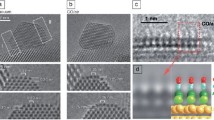Abstract
The following article is based on the Von Hippel Award address given by Knut W. Urban, chair of experimental physics at RWTH Aachen University and director of the Institute of Microstructure Research within the Department of Solid-State Research at the Jülich Research Center. Urban presented his award talk on November 29, 2006, during the 2006 Materials Research Society Fall Meeting in Boston. He was recognized with MRS’s highest honor, the Von Hippel Award, for his “sustained contributions to the development and use of electron microscopy, and for major discoveries in the defect physics of quasicrystals and high-temperature superconductors.” The Von Hippel Award honors those qualities most prized by materials scientists and engineers—brilliance and originality of intellect, combined with vision that transcends the boundaries of conventional scientific disciplines, as exemplified by the life of Arthur von Hippel (http://vonhippel.mrs.org).
In this article, Urban describes the advances in spherical-aberration-corrected electron optics that have set transmission electron microscopy on an entirely new track in materials science. The new imaging theory for aberration-corrected instruments is based on exploiting both lens focus and spherical aberration as variable parameters to optimize contrast, resolution, and point spread. The novel negative-spherical-aberration imaging technique makes it possible to image low-nuclear-charge atoms, which were previously inaccessible directly by electron microscopy. This technique has proven particularly successful for research on oxides. Due to negligible point spread, quantitative measurements of atomic-site occupancies, which are equivalent to local concentrations, have become feasible. These improvements are dramatically expanding the potential of electron microscopy for quantitative studies in materials science.
Similar content being viewed by others
References
O. Scherzer, Z. Phys. 101, 593 (1936).
O. Scherzer, Optik 2, 114 (1947).
H. Rose, Optik 85, 19 (1990).
M. Haider, S. Uhlemann, E. Schwan, H. Rose, B. Kabius, K. Urban, Nature 392, 768 (1998).
O. Scherzer, J. Appl. Phys. 20, 20 (1949).
M. Lentzen, B. Jahnen, C.L. Jia, A. Thust, K. Tillmann, K. Urban, Ultramicroscopy 92, 233 (2002).
M. Lentzen, Ultramicroscopy 99, 211 (2004).
C.L. Jia, M. Lentzen, K. Urban, Science 299, 870 (2003).
A. Rečnik, J. Bruley, W. Mader, D. Kolar, M. Rühle, Philos. Mag. B 70, 1021 (1994).
C.L. Jia, K. Urban, Science 303, 2001 (2004).
C.L. Jia, A. Thust, K. Urban, Phys. Rev. Lett. 95, 225506 (2005).
W.M. Coene, A. Thust, M. Op de Beeck, D. Van Dyck, Ultramicroscopy 64, 109 (1996).
K. Tillmann, A. Thust, K. Urban, Microsc. Microanal. 10, 185 (2004).
L. Houben, A. Thust, K. Urban, Ultramicroscopy 106, 200 (2006).
P.E. Batson, N. Dellby, O.L. Krivanek, Nature 418, 617 (2002).
P.D. Nellist, M.F. Chisholm, N. Dellby, O.L. Krivanek, M.F. Murfitt, Z.S. Szilagyi, A.R. Lupini, A. Borisevich, W.H. Sides Jr., S.J. Pennycook, Science 305, 1741 (2004).
Rights and permissions
About this article
Cite this article
Urban, K.W. The New Paradigm of Transmission Electron Microscopy. MRS Bulletin 32, 946–952 (2007). https://doi.org/10.1557/mrs2007.193
Published:
Issue Date:
DOI: https://doi.org/10.1557/mrs2007.193




